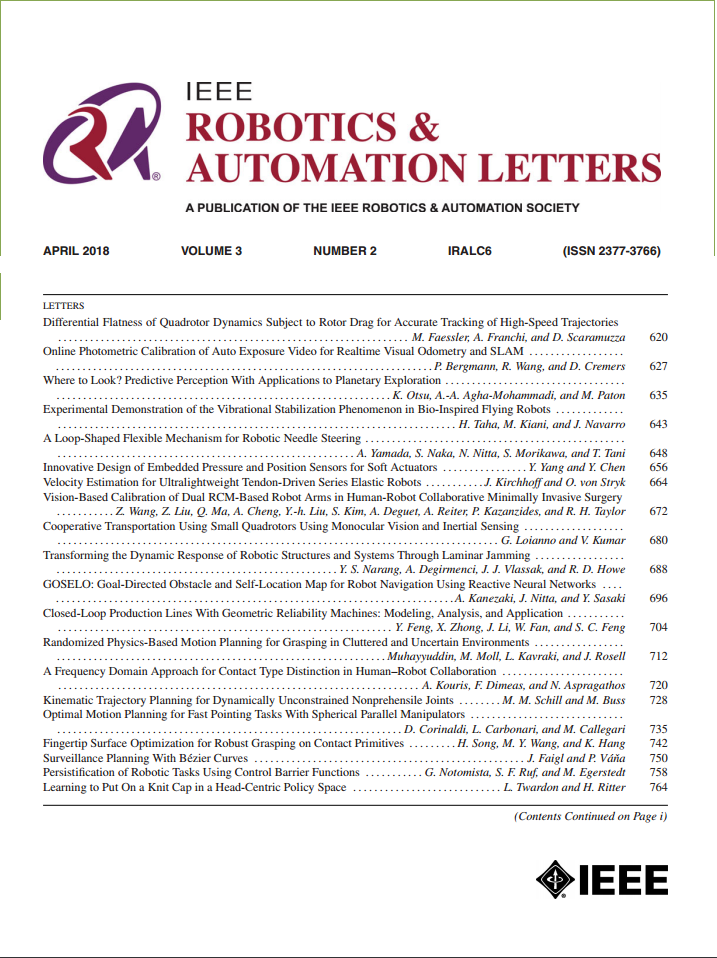Double-Feedback: Enhancing Large Language Models Reasoning in Robotic Tasks by Knowledge Graphs
IF 4.6
2区 计算机科学
Q2 ROBOTICS
引用次数: 0
Abstract
Large language models (LLMs) have demonstrated remarkable reasoning capabilities. However, in real-world robotic tasks, LLMs face grounding issues and lack precise feedback, resulting in the generated solutions deviating from the actual situation. In this letter, we propose Double-Feedback, a method that enhances LLMs reasoning by Knowledge graphs (KGs). The KGs play three key roles in Double-Feedback: prompting the LLMs to generate solutions, representing the task scenes, and verifying the solutions to provide feedback. We design structured knowledge prompts that convey the task knowledge background, example solutions, revision principles, and robotic tasks to the LLMs. We also introduce the distributed representation to quantify the task scene with interpretability. Based on the structured knowledge prompts and the distributed representation, we employ the KGs to evaluate the feasibility of each step before execution and verify the effects of the solutions after completing the tasks. The LLMs can adjust and replan the solutions based on the feedback from the KGs. Extensive experiments demonstrate that Double-Feedback outperforms prior works in the ALFRED benchmark. In addition, ablation studies show that Double-Feedback guides LLMs in generating solutions aligned with robotic tasks in the real world.双反馈:利用知识图谱增强机器人任务中的大型语言模型推理
大型语言模型(llm)已经证明了卓越的推理能力。然而,在现实的机器人任务中,llm面临接地问题,缺乏精确的反馈,导致生成的解决方案偏离实际情况。在这封信中,我们提出了双反馈,一种通过知识图(KGs)增强llm推理的方法。kg在双反馈中起着三个关键作用:提示llm生成解决方案,代表任务场景,验证解决方案以提供反馈。我们设计结构化的知识提示,向法学硕士传达任务知识背景、示例解决方案、修订原则和机器人任务。我们还引入了分布式表示来量化具有可解释性的任务场景。在结构化知识提示和分布式表示的基础上,我们采用KGs在执行前评估每个步骤的可行性,并在完成任务后验证解决方案的效果。llm可以根据KGs的反馈调整和重新规划解决方案。大量的实验表明,双反馈在ALFRED基准测试中优于先前的工作。此外,消融研究表明,双反馈指导法学硕士生成与现实世界中机器人任务一致的解决方案。
本文章由计算机程序翻译,如有差异,请以英文原文为准。
求助全文
约1分钟内获得全文
求助全文
来源期刊

IEEE Robotics and Automation Letters
Computer Science-Computer Science Applications
CiteScore
9.60
自引率
15.40%
发文量
1428
期刊介绍:
The scope of this journal is to publish peer-reviewed articles that provide a timely and concise account of innovative research ideas and application results, reporting significant theoretical findings and application case studies in areas of robotics and automation.
 求助内容:
求助内容: 应助结果提醒方式:
应助结果提醒方式:


